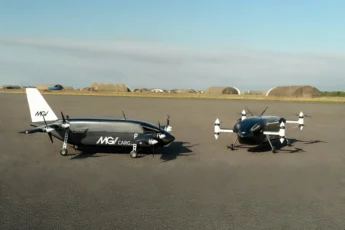What Are Electronic Warfare Resistant Drones?
Electronic warfare resistant drones are unmanned aerial vehicles (UAVs) designed to function in environments flooded with signal jamming, spoofing, or disruption. These systems use hardened communications, autonomous navigation, and mission-continuity protocols to complete objectives even without operator input or GPS access.
Why Are EW-Resistant Drones Crucial in Modern Defence?
In modern conflicts, spectrum dominance can be the difference between mission success and failure. Adversaries are increasingly deploying electronic attack systems to disrupt communications and disable UAVs mid-flight. Traditional drones, reliant on satellite or radio control, become ineffective or even dangerous in such environments.
EW-resistant drones provide:
- ✔️ Mission assurance in GPS-denied or communication-contested zones
- ✔️ Autonomous functionality when command-and-control (C2) is lost
- ✔️ Reduced vulnerability to enemy detection and interception
- ✔️ Operational continuity for ISR, resupply, or strike missions
These capabilities are essential for autonomous logistics in denied environments, where traditional UAVs often become ineffective.
Key Features of Electronic Warfare Resistant UAVs
MGI Defence is applying its F1-derived engineering and lightweight composite design to develop resilient drones that thrive in the harshest signal environments. Features include:
1. Encrypted, Multi-Channel Communications
Redundant RF links, frequency hopping, and AES-256 encryption keep drones connected when under active jamming.
2. GNSS-Independent Navigation
Inertial navigation systems (INS), terrain matching, and visual odometry enable operation without GPS reliance.
3. AI-Powered Autonomy
Onboard edge computing allows drones to assess conditions, reroute missions, and self-correct in real time.
4. Low Electromagnetic Signature
Stealthy design reduces the chance of detection by enemy electronic surveillance systems.
5. Pre-programmed Fallback Logic
If a drone detects interference, it can autonomously complete its mission or return to base without input.
How Do Electronic Warfare Resistant Drones Work?
When a drone enters an electronic warfare zone, hostile actors may attempt to jam control signals, spoof GPS coordinates, or flood the spectrum with noise. In response, an EW-resistant drone:
- Detects interference via onboard sensors.
- Switches to backup comms channels, or fully autonomous mode.
- Uses onboard maps and INS to navigate toward its objective.
- Completes its mission without real-time operator input.
Their ability to react in real-time makes them far more reliable than conventional UAVs in contested airspace.
Use Cases Across the Battlespace
| Application | Example Mission |
|---|---|
| ISR in contested airspace | Monitor enemy movement when links are denied |
| One-way precision strike | Navigate jamming zones to reach high-value targets |
| Ship-to-shore autonomous resupply | Deliver cargo through EW-contested coastal zones |
| Swarm operations | Maintain coordination without central control |
| Battlefield medical delivery | Complete aid missions in denied environments |
What Technologies Enable EW Resistance?
MGI Defence integrates cutting-edge technologies into each platform:
- Lightweight composites from F1 for low weight and reduced RCS
- AI onboard computing for mission decisions at the edge
- Modular payloads for role-specific electronics and sensors
- Rapid development cycles for operational readiness in weeks
FAQs
What makes a drone resistant to electronic warfare?
An EW-resistant drone can continue its mission under jamming, spoofing, or link failure. This is achieved via hardened comms, AI autonomy, and GNSS-independent navigation.
Can EW-resistant drones fly without GPS?
Yes. Our drones use inertial measurement units (IMUs), terrain following, and visual SLAM to maintain accurate navigation in GPS-denied areas.
What happens if a drone loses its connection to the operator?
MGI Defence drones are preloaded with fallback behaviours. Depending on the mission profile, they can autonomously return, continue, or loiter until reconnected.
Why Choose MGI Defence?
MGI Defence platforms are not retrofitted for denied environments — they are built for them from day one.
- Engineered for autonomy
- Modular and scalable
- Cost-efficient for volume deployment
- Proven rapid prototyping from motorsport R&D
Ready for the Electromagnetic Battlefield
As the electromagnetic spectrum becomes increasingly weaponised, your autonomous systems must think, adapt, and act independently.
MGI Defence is leading the development of drones that operate when everything else is silent.






